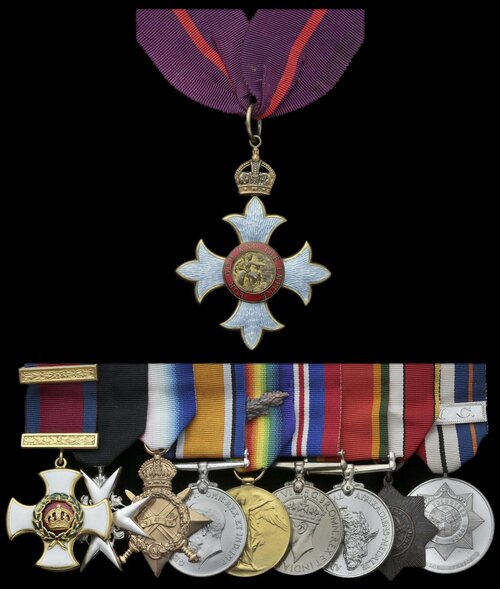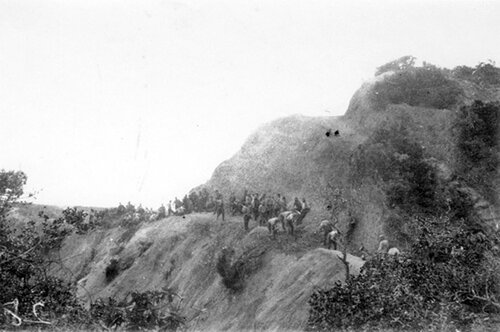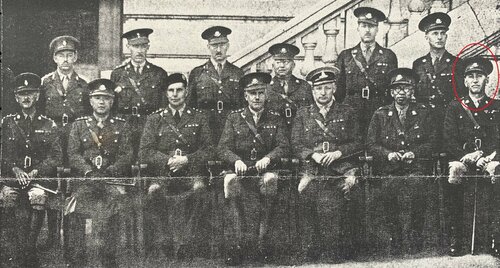Auction: 22001 - Orders, Decorations and Medals
Lot: 540
An impressive C.B.E., D.S.O., Order of St John group of ten awarded to Major E. G. Gauntlett, Royal Army Medical Corps, who was Senior Medical Officer of the Shanghai Volunteer Corps - Gauntlett suffered the privations of captivity upon the Japanese invasion with his wife and two children, one of whom died during their captivity
The Most Excellent Order of the British Empire, C.B.E. (Military) Commander’s 1st Type neck Badge, silver-gilt and enamel; Distinguished Service Order, G.V.R., silver-gilt and enamel, top riband bar adapted for wear; The Order of St. John of Jerusalem, Honorary Associate's Badge, silver; 1914-15 Star (Capt. E. G. Gauntlett. R.A.M.C.); British War and Victory Medals, with M.I.D. oak leaves (Major E. G. Gauntlett.); War Medal 1939-45; Africa Service Medal 1939-45 (Major E. G. Gauntlett), privately impressed naming; Shanghai Municipal Council Emergency Medal 1937, bronze, unnamed as issued; Shanghai Volunteer Corps Long Service Medal, silver, with 'S.V.C.' Bar, reverse inscribed 'Major E. G. Gauntlett Act. 1920-1932', mounted for wear, cleaned, very fine (10)
C.B.E. London Gazette 1 January 1918.
D.S.O. London Gazette 1 January 1918.
Appointed Honarary Associate, Order of St John, 27 May 1927.
Eric Gerald Gauntlett was born on 1 November 1885. Perhaps the best biography is offered by the Royal College of Surgeons of England:
'...the son of T L Gauntlett of Putney, he was educated at King's College School, Wimbledon Common and entered King's College Hospital Medical School with the Warneford Scholarship in 1902. The hospital was then still in Portugal Street, just south of the Royal College of Surgeons. He won several prizes and scholarships during his student years, and qualified with the Conjoint Diploma in 1908. He graduated through London University, with honours in medicine, surgery and forensic medicine, and was awarded a University gold medal, in 1920; he took the Fellowship in 1911. At King's he was house surgeon to Watson Cheyne, Sambrooke Surgical Registrar and tutor in succession to Arthur Edmunds.'
Upon the outbreak of the Great War, Gauntlett was first a Corporal at the 13th Casualty Clearing Station, before being commissioned. He served on Gallipoli (MIC notes 'ANZAC') from 5 November 1915, with the 1st City of London Field Ambulance on Walker's Ridge. The unit had been one of the first Territorial units to leave England, when they departed for Malta. Gauntlett was one of their fourteen Officers to depart for War. In early December, Gauntlett wrote up the War Diary, which recalls scores of casualties being removed by ship, no less than 1220 being 'taken off' in the period 8-14 December, after which he assumed Command of the unit with Major Elleny having left aboard Hospital Ship. After the evacuation, he thence served at Salonika, at place that he met his future wife, who was working with the Voluntary Aid Detachment. Gauntlett finished the Great War with a trio of 'mentions' (London Gazettes 21 July & 28 November 1917 and 5 June 1919, refer) to go with his brace of decorations and served as an Acting Lieutenant-Colonel.
The Royal College continues his story:
'When he returned to civil practice he was appointed assistant surgeon to Paddington Green Children's Hospital, but soon accepted the post of chief medical officer to the Shanghai-Nanking Railway in China. He worked at Shanghai for nearly twenty years, constructing a large surgical practice among the British and other European residents the British Embassy staff, and wealthy Chinese. He had a hospital available and was on the staff. He was also senior medical officer to the Shanghai Volunteers. Gauntlett was an enthusiastic Freemason, and at one time District Senior Grand Warden of the North China Lodges. His three sons were educated at Uppingham.
When the Japanese invaded China in 1939 he, his wife and their two elder sons were interned. During internment one son contracted typhoid and died, largely as a result of deprivation of medical facilities. After about a year an exchange of Embassy staffs released him, his wife, and their surviving son from internment. Mrs Gauntlett brought with her 20 children of other internees. They sailed under Red Cross protection to Lourcenio in Portuguese East Africa. Their son, aged only 17, joined the South African Air Force and fought in it for the rest of the war.
Gauntlett joined the South Africa Medical Corps and worked as a surgeon in the rank of Major in South Africa. By this means he released a younger man for active service abroad. Mrs Gauntlett nursed in military hospitals in South Africa throughout the war.
As a result of the disaster at Shanghai, Gauntlett lost nearly all his property, his investments, his pensions rights, and the value of his partnership. He had no income except his salary in the South African Army while serving from 1942 to 1946.
When hostilities ceased he returned to England. He owned a small property, which had been used by Mrs Gauntlett on long leave from Shanghai, to be near her sons when they were young. They sold this property and some silver which provided a small block of capital, with which, at the age of 63, he entered general practice in the Doctors Panter and Mayo partnership at Braintree, Essex. He worked in this practice for seventeen years, and was on the staffs of several neighbouring hospitals.
He was active in the British Medical Association, serving as chairman on the Mid-Essex Division 1951-53 and Branch 1958-60. He maintained his interest in Freemasonry, and became Senior Member of King's College Hospital Lodge.
He retired at the age of 80 to Colchester where he died on 26 November 1972 after fracturing his hip in a fall, aged 87.'
Sold together with copied research and extracts, including his South African Service Record, which confirm his Second World War Medals were issued in September 1956.
Subject to 20% VAT on Buyer’s Premium. For more information please view Terms and Conditions for Buyers.
Sold for
£5,000
Starting price
£2400









